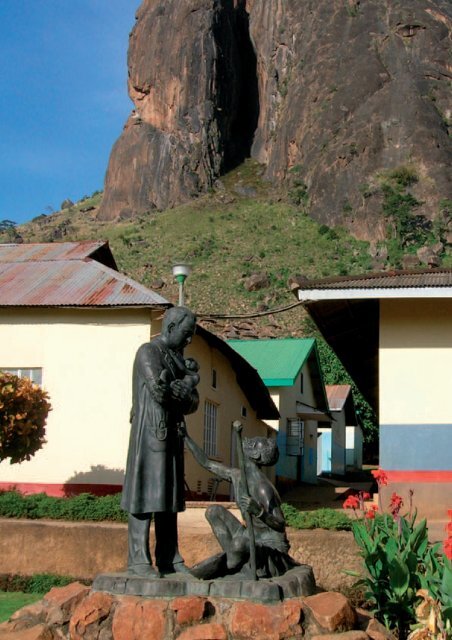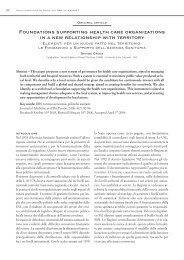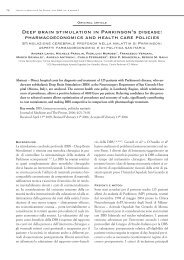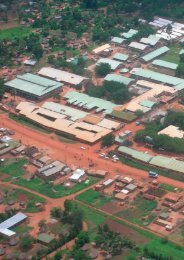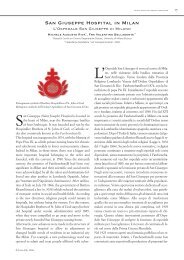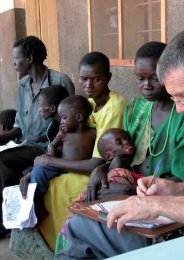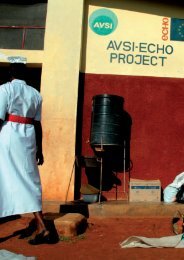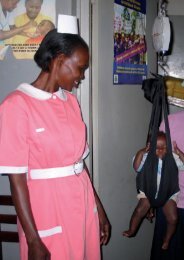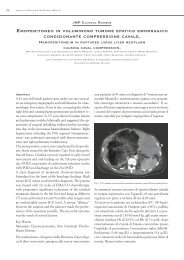4_Kalongo Hospital - Journal of Medicine and the Person
4_Kalongo Hospital - Journal of Medicine and the Person
4_Kalongo Hospital - Journal of Medicine and the Person
You also want an ePaper? Increase the reach of your titles
YUMPU automatically turns print PDFs into web optimized ePapers that Google loves.
Dr.Ambrosoli Memorial<br />
<strong>Hospital</strong>, <strong>Kalongo</strong><br />
Year <strong>of</strong> Foundation: 1957<br />
Management: Archdiocese <strong>of</strong> Gulu<br />
Number <strong>of</strong> beds: 320<br />
Staff: 135 Qualified 169 Unqualified<br />
Medical Officers: 4<br />
Outpatients 2004/05: 58.462<br />
Inpatients 2004/05: 13.336<br />
Inpatient Mortality: 2,2%<br />
Children’s Mortality: 2,1%<br />
Average Length Of hospital Stay: 8 days<br />
Bed Occupancy Rate: 89%<br />
Background<br />
Dr Ambrosoli Memorial <strong>Hospital</strong> is a private not for pr<strong>of</strong>it<br />
health institution with social <strong>and</strong> spiritual aims belonging to<br />
<strong>the</strong> Catholic Archdiocese <strong>of</strong> Gulu, <strong>of</strong>ficially recognized by <strong>the</strong><br />
Ug<strong>and</strong>a Government in 1957. It was started in 1934 by Sister<br />
Eletta Mantiero, a Comboni Missionary sister, as a small<br />
dispensary in a grass hut which rapidly developed into a<br />
maternity <strong>and</strong> medical unit. With <strong>the</strong> arrival <strong>of</strong> Fa<strong>the</strong>r Giuseppe<br />
Ambrosoli, who spent more than 30 years in <strong>Kalongo</strong>, <strong>the</strong><br />
hospital was built <strong>and</strong> developed with <strong>the</strong> support <strong>of</strong> many<br />
Comboni Missionaries, <strong>the</strong> congregation <strong>of</strong> <strong>the</strong> Sisters <strong>of</strong> Mary<br />
Immaculate <strong>and</strong> several expatriate doctors.<br />
In 1959 Dr Ambrosoli <strong>of</strong>ficially opened <strong>the</strong> “St. Mary’s<br />
Midwifery School”. The first group <strong>of</strong> students qualified in 1961<br />
<strong>and</strong> <strong>the</strong> institution soon reached a well known reputation all<br />
over Ug<strong>and</strong>a. Since its start over 900 Midwives qualified from<br />
<strong>the</strong> school.<br />
From February 1987 to November 1989, <strong>Kalongo</strong> Mission, <strong>the</strong><br />
<strong>Hospital</strong> <strong>and</strong> <strong>the</strong> School were evacuated following a<br />
Government’s decision, due to <strong>the</strong> war. Dr Ambrosoli died in<br />
Lira on <strong>the</strong> 27th March, 1987 because <strong>of</strong> renal failure. His<br />
memory is still vivid in <strong>the</strong> local people who used to call him<br />
“<strong>the</strong> doctor <strong>of</strong> God.” From 1987 <strong>the</strong> hospital <strong>and</strong> <strong>the</strong> mission<br />
were protected against lootings by <strong>the</strong> local population. The<br />
hospital was <strong>of</strong>ficially reopened on December 2nd, 1989 <strong>and</strong> Dr<br />
Fa<strong>the</strong>r Egidio Tocalli was appointed as Superintendent. The<br />
Midwifery School was temporarily moved to Angal <strong>Hospital</strong> in<br />
1987 to continue training midwives <strong>and</strong> was brought back to<br />
<strong>Kalongo</strong> in 1990.
Context <strong>and</strong> Location<br />
<strong>Kalongo</strong>’s Dr. Ambrosoli Memorial <strong>Hospital</strong> (KAMH) is <strong>the</strong> only hospital in Pader District (populated by<br />
over 330.000 people), Acholi Subregion, Nor<strong>the</strong>rn Ug<strong>and</strong>a. It is situated in <strong>Kalongo</strong> town, Parabongo<br />
Sub-County, Agago County. In 2001 <strong>the</strong> establishment <strong>of</strong> a new District in Pader, forcibly made <strong>Kalongo</strong><br />
<strong>the</strong> head <strong>of</strong> <strong>the</strong> Health Sub-District, to manage health in <strong>the</strong> whole district, both in Agago <strong>and</strong> in Aruu<br />
Counties. Due to access difficulties KAMH mostly serves a nearby population, <strong>and</strong> due to its isolation<br />
from o<strong>the</strong>r centres, it has to function not only as a district but as a referral (secondary) hospital for <strong>the</strong><br />
whole district. The neighbouring districts <strong>of</strong> Kitgum, Lira <strong>and</strong> Kotido at times also benefit <strong>of</strong> it as referral<br />
hospital.<br />
Because <strong>of</strong> insecurity, over 50.000 people in <strong>Kalongo</strong> are currently living within an Internally Displaced<br />
People (IDP) camp, in critical conditions, with poor sanitation.<br />
KAMH has <strong>the</strong> duty <strong>of</strong> supervising all <strong>the</strong> lower health units <strong>of</strong> Pader District (7 Health Centres III <strong>and</strong> 7<br />
Health Centres II).<br />
Since <strong>the</strong> insurgency intensified in June 2002, road travelling is ra<strong>the</strong>r insecure <strong>and</strong> allowed only with military<br />
escort. In order to reach Pader headquarters, located 80 km away from <strong>Kalongo</strong>, it is necessary to<br />
make a detour <strong>of</strong> 138 Km.<br />
The only alternative, although very expensive, is air transport <strong>of</strong> personnel, drugs <strong>and</strong> sundries. The hospital<br />
is in <strong>the</strong> process <strong>of</strong> extending <strong>the</strong> airfield to allow bigger planes to l<strong>and</strong>, to facilitate <strong>the</strong> lifeline with<br />
Kampala, vital in such context.<br />
A mobile phone communication network, already covering part <strong>of</strong> <strong>the</strong> district, is currently being set up for<br />
<strong>Kalongo</strong> town <strong>and</strong> <strong>the</strong> hospital. For <strong>the</strong> time being, KAMH still relies on a radio call communication system<br />
which links to <strong>the</strong> district headquarters <strong>and</strong> <strong>the</strong> neighbouring hospitals <strong>and</strong> on E-mail connection.
Dr. Ambrosoli Memorial <strong>Hospital</strong>, <strong>Kalongo</strong> 37<br />
<strong>Hospital</strong> Mission<br />
To <strong>of</strong>fer services with a commitment to a holistic approach in healing by treating <strong>and</strong> preventing diseases,<br />
with preferential option for <strong>the</strong> less privileged.<br />
HOSPITAL PROFILE<br />
Outpatient Services<br />
The Out Patient Department is open from Monday to Saturday <strong>and</strong> is covered by 5 clinical <strong>of</strong>ficers. Doctors<br />
join <strong>the</strong>m when <strong>the</strong>y have finished <strong>the</strong> ward activities taking care <strong>of</strong> medical obstetric/gynaecological,<br />
paediatric, surgical <strong>and</strong> dermatological cases. Services include laboratory, diagnostic imaging (X-ray <strong>and</strong><br />
Ultrasound), Ante-Natal Clinic (ANC) <strong>and</strong> Physio<strong>the</strong>rapy. OPD attendance is boosted by insecurity (many<br />
patients could be seen at lower level health units), <strong>the</strong> poor health <strong>and</strong> nutritional status <strong>of</strong> <strong>the</strong> population<br />
<strong>and</strong> <strong>the</strong> lack <strong>of</strong> alternatives for cure. Not only <strong>the</strong>re is no o<strong>the</strong>r hospital as in Kitgum <strong>and</strong> Gulu, but <strong>the</strong><br />
health system <strong>of</strong> Pader District has deteriorated as a whole <strong>and</strong> <strong>the</strong> lack <strong>of</strong> staff in <strong>the</strong> peripheral units has<br />
also contributed to poor service provision. The majority <strong>of</strong> <strong>the</strong> population served resides in <strong>the</strong> <strong>Kalongo</strong><br />
IDP camp. In order to help IDPs, since November 2002 <strong>the</strong> fees for paediatric <strong>and</strong> maternal consultations<br />
were lowered to 100 Ug<strong>and</strong>an Shillings (5 Eurocents) resulting in a surge in overall OPD attendance. The<br />
number <strong>of</strong> patients seen in KAMH OPD (figure 1) has been constantly increasing until 2004 when a peak<br />
<strong>of</strong> 60.465 was recorded. In 2005 patients were 58.462 (3% less). Considering <strong>the</strong> increase in ANC <strong>of</strong> 18%,<br />
OPD only reduced its performance by 2%.<br />
Figure 1. OPD trend <strong>of</strong> contacts during ECHO intervention<br />
© Punto Effe, 2006
Figure 2. OPD Top 10 diagnoses in <strong>the</strong> last 3 financial years.
Dr. Ambrosoli Memorial <strong>Hospital</strong>, <strong>Kalongo</strong> 39<br />
Impatient Activity<br />
The hospital is presently equipped with 320 beds, distributed among a Medical Ward, a Surgical Ward, a<br />
Children’s Ward, a Nutrition Unit, <strong>and</strong> a Maternity Ward (Table 1).<br />
The inpatient numbers at <strong>Kalongo</strong> have been constantly rising during <strong>the</strong> last three financial years, <strong>and</strong> <strong>the</strong>y still<br />
rose from 2003/2004 to 2004/2005 by 10% (13.078 versus 11.815 <strong>of</strong> 2003/2004 <strong>and</strong> 9.440 <strong>of</strong> 2002/2003) regardless<br />
<strong>of</strong> a 2% decrease in OPD contacts (figure 1). At <strong>the</strong> same time, <strong>the</strong>re is a uniform improvement in mortality<br />
rates from <strong>the</strong> previous years. Since AVSI <strong>and</strong> ECHO intervention began overall CFR decreased from<br />
4,7% in 2002/2003 to 3,6% in 2003/2004 <strong>and</strong> 2,2% in 2004/2005 (figure 4). The lower death rates are related<br />
both to improved medical supervision on <strong>the</strong> wards, as well as to a likely lesser acuity <strong>of</strong> admitted patients. Meaning<br />
that <strong>the</strong> increase <strong>of</strong> admissions might not concern only acute critical cases but better management <strong>of</strong> preacute<br />
patients. Overall, mortality rates have decreased by disease <strong>and</strong> in every ward (figure 4 <strong>and</strong> 6).<br />
Ward<br />
Beds<br />
Ward<br />
Beds<br />
Ward<br />
Beds<br />
Ward<br />
Beds<br />
Surgical Ward 76<br />
Medical Ward 85<br />
Children Ward 83<br />
Maternity Ward 76<br />
Adults 70<br />
Main ward 40<br />
Main ward 43<br />
Main ward 66<br />
Children 6<br />
Tuberculosis 24<br />
Isolation 22<br />
Premature<br />
10 cots<br />
Isolation 21<br />
Nutrition Unit 18<br />
Table 1. KAMH bed allocation.<br />
Figure 3. Ten leading causes <strong>of</strong> admission<br />
© Punto Effe, 2006
SUPPLEMENT NUMBER 1, JOURNAL OF MEDICINE & THE PERSON. JUNE 2006, VOL. 4<br />
TB patients started on treatment have increased from 185 to 258 in <strong>the</strong> last 12 months, while it seemed due<br />
to insurgency <strong>the</strong> lowest peak <strong>of</strong> 2002/2003 with only 77 TB patients treated.<br />
Deliveries have also increased due to incentives from 2.191 <strong>of</strong> 2002/2003 <strong>and</strong> 2005 <strong>of</strong> 2003/2004 to 3.303<br />
<strong>of</strong> 2004/2005<br />
<strong>Hospital</strong> Staff<br />
Qualified staff are 100 out <strong>of</strong> 243 (41%).The hospital plan is to reduce unqualified staff upon contract<br />
expiry in order to pay remaining staff at rates more competitive with <strong>the</strong> increase to Ug<strong>and</strong>an<br />
government staff.<br />
St. Mary’s Midwifery School is located on site. A renovation <strong>of</strong> <strong>the</strong> school with construction <strong>of</strong> new buildings<br />
is under way. The training is more than just midwifery, <strong>and</strong> <strong>the</strong> school is in <strong>the</strong> process <strong>of</strong> transition<br />
to a Comprehensive Nursing school. The midwives that remain at KAMH appear to be well selected, <strong>and</strong><br />
adapt readily to a variety <strong>of</strong> job descriptions.<br />
To help student midwives to complete <strong>the</strong>ir required 20 deliveries from first stage during school before sitting<br />
for Government examination, KAMH encourages mo<strong>the</strong>rs to deliver within <strong>the</strong> hospital by supplying<br />
1 kg <strong>of</strong> sugar <strong>and</strong> salt <strong>and</strong> 1 bar <strong>of</strong> soap to those who come at first stage <strong>of</strong> labour. All normal deliveries are<br />
free <strong>of</strong> charge.<br />
The hospital has been looking more onto <strong>the</strong> local community as a source <strong>of</strong> staffing, by identifying suitable<br />
c<strong>and</strong>idates <strong>and</strong> sending <strong>the</strong>m for training with an agreement to come back to serve <strong>the</strong> hospital <strong>and</strong><br />
<strong>the</strong>ir own people. Isolation also encourages staff not to drift to nearby institutions. Plus, <strong>the</strong> administration<br />
is very stable which encourages stability <strong>of</strong> staff.<br />
Accommodation is given to <strong>the</strong> staff according to <strong>the</strong> availability <strong>and</strong> needs. Currently about 42 % <strong>of</strong> <strong>the</strong><br />
employees reside within <strong>the</strong> hospital premises. There is still need for more houses to accommodate <strong>the</strong>m.<br />
Figure 4. Case Fatality Rate by ward <strong>and</strong> total in <strong>the</strong> last three financial years.
Dr. Ambrosoli Memorial <strong>Hospital</strong>, <strong>Kalongo</strong> 41<br />
Figure 5. Average n. <strong>of</strong> admissions per day, Average Length <strong>of</strong> <strong>Hospital</strong> Stay <strong>and</strong> Bed Occupancy rate in <strong>the</strong> last three financial years.<br />
Figure 6. Inpatients trend <strong>of</strong> admission, recovery <strong>and</strong> death in <strong>the</strong> last three financial years.<br />
© Punto Effe, 2006
42<br />
<strong>Kalongo</strong><br />
AVSI-ECHO Interventions in <strong>Kalongo</strong> <strong>Hospital</strong><br />
ECHO Ug<strong>and</strong>a 4 project: OCTOBER 2002 TO JANUARY 2003<br />
Budget: 52.500.000 Ug<strong>and</strong>a Shillings (27.300 Euros)<br />
• Drugs <strong>and</strong> transport<br />
• Construction <strong>of</strong> Ventilated Pit Latrines.<br />
ECHO Ug<strong>and</strong>a 5 Project: FEBRUARY 2003 TO APRIL 2004.<br />
BUDGET: 205.300.000 Ug<strong>and</strong>a Shillings (92.300 Euros)<br />
• Support to 2 Medical Doctors.<br />
• Support to 5 health workers <strong>and</strong> 1 night guard.<br />
• Drugs, equipment, <strong>and</strong> disinfectant.<br />
• Food for patients.<br />
• Supplies <strong>and</strong> fuel for generator <strong>and</strong> vehicles<br />
• Repair <strong>and</strong> support for hospital ambulance.<br />
• Construction <strong>and</strong> fencing <strong>of</strong> night commuter shelter.<br />
• Perimeter walls <strong>of</strong> night commuter shelters for protection from attacks.<br />
• Construction <strong>of</strong> heat-pro<strong>of</strong> incinerator.<br />
• Implementation <strong>of</strong> emergency preparedness training <strong>and</strong> production <strong>of</strong> emergency procedures manual.<br />
• Renovation <strong>of</strong> <strong>the</strong> IV Fluids Production Unit.<br />
• Sanitation support with <strong>the</strong> emptying <strong>of</strong> permanent latrines <strong>and</strong> septic tanks in <strong>the</strong> <strong>Kalongo</strong> Town area <strong>and</strong><br />
hospital, <strong>and</strong> latrine construction for patients/night commuters.<br />
ECHO 7 PROJECT: April 2004 to March 2005.<br />
BUDGET: 169.890.000 Ug<strong>and</strong>an Shillings ( 78.400 Euros)<br />
• Support to 4 Ug<strong>and</strong>an Medical Doctors, directly employed by KAMH.<br />
• Salary support for health workers <strong>and</strong> support staff as determined by hospital budget <strong>and</strong> needs.<br />
• Food for patients.<br />
• Medical drugs/sundries <strong>and</strong> disinfectants.<br />
• Medical equipment.<br />
• Solar Powered Laundry.<br />
• Fuel, maintenance <strong>and</strong> spare parts for generator <strong>and</strong> hospital ambulance/vehicle.
FRONT LINE HEALTH WORKERS<br />
Egidio Tocalli<br />
Egidio Tocalli, 62 is a Combonian missionary who, already a priest, studied as a doctor in Italy <strong>and</strong> attended,<br />
after graduation in 1974, a surgical training <strong>of</strong> one year in Engl<strong>and</strong>. In 1976 he worked in <strong>Kalongo</strong> with Fa<strong>the</strong>r<br />
Ambrosoli. After that first experience he began a training program as a gynaecologist <strong>and</strong> at <strong>the</strong> same time was<br />
appointed in Aber <strong>Hospital</strong> in Pacwac District. After 5 years, in 1982 he was transferred to Lira district, to take<br />
care <strong>of</strong> <strong>the</strong> little leprosy center, an experience that he recalls happily because <strong>of</strong> <strong>the</strong> large commitment to preventive<br />
medicine, successful multidrug <strong>the</strong>rapy reducing <strong>the</strong> total number <strong>of</strong> cases from 8 thous<strong>and</strong> to 500 <strong>and</strong><br />
health education not to fear leprosy any longer because it could be treated <strong>and</strong> was not infectious as before. On<br />
March 27th, 1987 Egidio went with a military helicopter to rescue Fa<strong>the</strong>r Ambrosoli in Lira but he only reached<br />
after his death due to renal failure. Two years later, in November 1989, Egidio was to reopen <strong>the</strong> hospital.<br />
In 1990 he brought back <strong>the</strong> Midwifery School from Angal.<br />
«For years <strong>the</strong> hospital hosted up to 11thous<strong>and</strong> night commuters to sleep within <strong>the</strong> compound. ECHO built<br />
<strong>the</strong> hospital protection walls through AVSI <strong>and</strong> some <strong>of</strong> <strong>the</strong> 18 shelters for night commuters that are used as<br />
schools for displaced people during day time. A displaced village has grown on <strong>the</strong> mountain side. The mountain<br />
remains a big danger for epidemics, especially cholera because it is difficult to build latrines on a slope».<br />
Egidio has worked hard to bring Ug<strong>and</strong>an doctors to work in <strong>Kalongo</strong>, paying <strong>the</strong>m 40% more than government<br />
salaries. «They have a poor social life because <strong>of</strong> <strong>the</strong> hospital isolation. We are surrounded by <strong>the</strong><br />
© Punto Effe, 2006
44<br />
SUPPLEMENT NUMBER 1, JOURNAL OF MEDICINE & THE PERSON. JUNE 2006, VOL. 4<br />
army with weapons <strong>and</strong> tanks. Mobile telephone connection are about to be implemented but until now<br />
communications with distant relatives are not possible. We linked <strong>the</strong> hospital to Internet <strong>and</strong> <strong>of</strong>fer it for<br />
free to doctors toge<strong>the</strong>r with satellite TV as an incentive to <strong>the</strong>ir coming. Every 3 months <strong>the</strong>y benefit <strong>of</strong> a<br />
week <strong>of</strong> rest <strong>and</strong> an air ticket because <strong>the</strong> road is dangerous». Egidio likes to describe <strong>the</strong> future <strong>of</strong> <strong>the</strong> hospital<br />
as “black”. «I do not mean dark. But black as Ug<strong>and</strong>an, considering that all position <strong>of</strong> full responsibility,<br />
from <strong>the</strong> Medical Superintendent, <strong>the</strong> administrators, <strong>the</strong> consultant surgeon <strong>and</strong> gynaecologist are<br />
in <strong>the</strong> process <strong>of</strong> being covered by trained Ug<strong>and</strong>an pr<strong>of</strong>essionals».<br />
Patrick Okao<br />
Patrick Okao, 35 years old, from Lira, is <strong>the</strong> Specialist Surgeon <strong>of</strong> Ambrosoli Memorial <strong>Hospital</strong>. A Makerere<br />
graduate in 1998, after internship in St. Mary’s <strong>Hospital</strong>, Lacor in Gulu, he went straight to <strong>Kalongo</strong><br />
where Fa<strong>the</strong>r Egidio Tocalli was looking for a doctor to replace a vacancy. «A classmate <strong>of</strong> mine informed<br />
me about this opportunity <strong>and</strong> I did not loose time». One month later, in December 1999, Pr<strong>of</strong>essor Bonini,<br />
<strong>the</strong> surgeon who had supervised his training in Lacor, also<br />
reached <strong>Kalongo</strong>. «I am still learning from him every day. He is <strong>the</strong><br />
one who decided to send me for fur<strong>the</strong>r studies in Mulago <strong>Hospital</strong>,<br />
a Master in Surgery from September 2001 all <strong>the</strong> way to 2005,<br />
being in frontline on major emergencies everyday».<br />
Patrick researched about <strong>the</strong> surgical management <strong>of</strong> burns in<br />
Mulago. Now he is back in <strong>Kalongo</strong> for at least three years as<br />
signed on his sponsorship program. «I find it a very adequate way<br />
<strong>of</strong> keeping doctors motivated to work in a difficult isolated environment».<br />
A pediatrician <strong>and</strong> a gynecologist are following him<br />
closely <strong>and</strong> will come back next year. But <strong>the</strong>re is ano<strong>the</strong>r motivating<br />
factor for a surgeon: efficiency. «To be able to do well your<br />
work is a source <strong>of</strong> satisfaction. And in <strong>the</strong> <strong>the</strong>atre it matters a lot.<br />
What is outst<strong>and</strong>ing in <strong>Kalongo</strong> is <strong>the</strong> tremendous effort <strong>the</strong> hospital puts in everything that is done. The<br />
school, <strong>the</strong> new buildings, <strong>the</strong> administration, <strong>the</strong> management <strong>and</strong> first <strong>of</strong> all patient’s care are all points<br />
<strong>of</strong> excellence. What I see as critical is independent from <strong>the</strong> hospital’s will. Poverty <strong>of</strong> <strong>the</strong> region affects<br />
everything. We are <strong>the</strong> only hospital in a very wide area. Patients cannot afford to pay, yet <strong>the</strong>re is good reasoning<br />
from <strong>the</strong> management to make <strong>the</strong>m pay as little as possible not to give <strong>the</strong>m everything for free. We<br />
hope to have in front <strong>of</strong> us improvement on security <strong>and</strong> poverty in order to raise one day again <strong>the</strong> user<br />
fees to an adequate cost sharing. Especially considering that, when security improves, patients pour in <strong>the</strong><br />
hospital <strong>and</strong> increase dramatically <strong>the</strong> workload».<br />
Alex Obwonyo<br />
Alex Obwonyo, <strong>the</strong> <strong>Hospital</strong> administrator, is 36 years old. His family was deeply signed by <strong>the</strong> encounter with<br />
Fa<strong>the</strong>r Ambrosoli, whom he knew since he was a child. He still remembers Fa<strong>the</strong>r Ambrosoli’s love for <strong>the</strong><br />
people <strong>and</strong> willingness to help everybody. «He was humble, kind, took everyone with <strong>the</strong> same interest, you
Dr. Ambrosoli Memorial <strong>Hospital</strong>, <strong>Kalongo</strong> 45<br />
felt as if someone was caring for you». Alex’s mo<strong>the</strong>r was one <strong>of</strong><br />
<strong>the</strong> first midwives <strong>and</strong> worked closely with him from <strong>the</strong> first<br />
training for assistant midwives that was carried out in <strong>the</strong> hospital.<br />
Alex’s sister was also trained as a midwife in <strong>Kalongo</strong>.<br />
Alex himself started in 1990 as a dark room attendant <strong>and</strong> trained<br />
on <strong>the</strong> job as assistant radiographer <strong>and</strong> assistant store-keeper.<br />
He knows how <strong>the</strong> hospital works from within. In 1996 he<br />
sat for a Diploma in Administration in <strong>the</strong> International Christian<br />
Medical Institute <strong>and</strong> <strong>the</strong> following year began working in<br />
<strong>the</strong> hospital administration. In 2001 he was sent for a 3 years<br />
course in Administration at <strong>the</strong> Ug<strong>and</strong>a Christian University <strong>of</strong> Mukono <strong>and</strong> since he achieved his degree he<br />
gradually took <strong>the</strong> full responsibility <strong>of</strong> KAMH administration.<br />
OVERVIEW<br />
The hospital is providing a high st<strong>and</strong>ard <strong>of</strong> care in all fields <strong>of</strong> intervention, especially thanks to highly<br />
qualified personnel, doctors <strong>and</strong> trained midwives, greatly benefiting from <strong>the</strong> presence <strong>of</strong> <strong>the</strong> school on<br />
site. Structural improvement <strong>of</strong> <strong>the</strong> hospital is under way within <strong>the</strong> school <strong>and</strong> <strong>the</strong> Maternity department<br />
<strong>and</strong> it is about to begin for OPD, under ECHO funds.<br />
Its financial future appears precarious <strong>and</strong> still dependent on foreign aid, although a gradual h<strong>and</strong>ing over<br />
to a Ug<strong>and</strong>an Medical Superintendent is planned in <strong>the</strong> next few years.<br />
Government provides approximately 35% <strong>of</strong> <strong>the</strong> total budget through Poverty Action Funds but payments<br />
delay even 3 months <strong>and</strong> force <strong>the</strong> administration to pay salaries out <strong>of</strong> o<strong>the</strong>r hospital budget. The<br />
ECHO support has chiefly allowed drug supply, <strong>the</strong> fee reduction, now accounting only for 2% <strong>of</strong> <strong>the</strong><br />
budget, <strong>and</strong> reasonable salaries to allow retention <strong>of</strong> some excellent Ug<strong>and</strong>an doctors. The fees are <strong>the</strong><br />
lowest <strong>of</strong> all <strong>the</strong> Non-for Pr<strong>of</strong>it <strong>Hospital</strong>s <strong>of</strong> Ug<strong>and</strong>a. In fact, not only OPD fees are low, but children pay<br />
in <strong>the</strong> Ward only 200 Ug<strong>and</strong>an Shillings (10 Eurocents) even if <strong>the</strong>y are hospitalized for long. Pregnant<br />
mo<strong>the</strong>rs do not pay fees for delivery. Children only pay 100 Ug<strong>and</strong>an Shillings for OPD contact <strong>and</strong> 200<br />
Ug<strong>and</strong>an Shillings for admissions. Women who need to undergo surgery only pay half <strong>of</strong> <strong>the</strong> fees.<br />
The hospital is bearing <strong>the</strong> responsibility <strong>of</strong> managing <strong>the</strong> HSD <strong>of</strong> Agago County <strong>and</strong> to fulfil its obligation<br />
<strong>of</strong> continuous support supervision to <strong>the</strong> lower level units <strong>of</strong> <strong>the</strong> government to ensure that district inhabitants<br />
living far away from KAMH can also access quality services. Although <strong>the</strong>re is insecurity KAMH<br />
managed to hold regular meetings with in-charges <strong>of</strong> peripheral health units belonging to <strong>the</strong> government<br />
to evaluate <strong>the</strong>ir work <strong>and</strong> train <strong>the</strong>m.<br />
The state <strong>of</strong> health services, though, apart from KAMH (<strong>and</strong> to a lesser extent, <strong>the</strong> small HC that <strong>the</strong> hospital<br />
supports) is generally poor in <strong>the</strong> district, creating a dependency <strong>of</strong> <strong>the</strong> population on <strong>the</strong> hospital<br />
for both primary <strong>and</strong> referred services where access is possible.<br />
© Punto Effe, 2006


